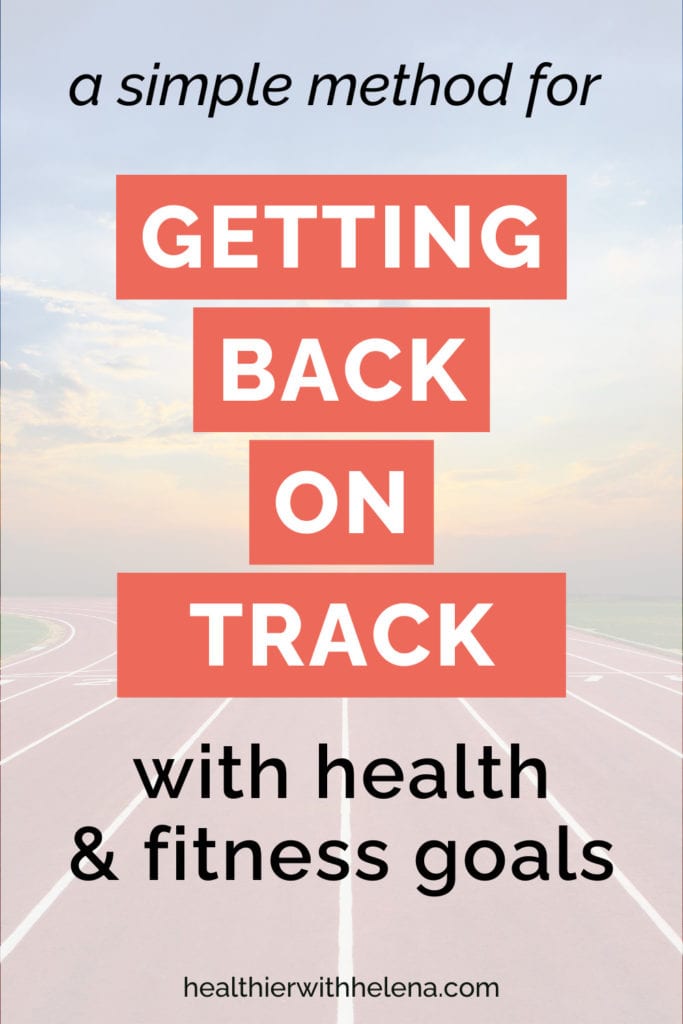We’ve all been there – you start doing a new health-related behavior, like eating more vegetables or exercising four days a week. It’s going so well that you start thinking “This is so easy, I’m going to be able to keep this up forever!” And then life happens. So in today’s post I’m going to share a simple method for getting back on track with health and fitness goals. It’s quick, it’s easy, and it works.
(Pin this post to read later)

Being a dietitian means I know a lot about nutrition and health. But it doesn’t make me perfect at being healthy. I also have two kids, chronically low energy, and a busy lifestyle. Following an exercise routine and eating properly everyday – well, that can be hard. So I’ve started following the advice that I’ve often given to others over the years. I’ve started caring for myself by taking it easy and giving myself the grace to do only what I can realistically manage.
One of the ways that I do this is by pushing the reset button when things get off track. For me, that means scaling back to the least amount of something that I am 100% confident I can do. So if I find myself skipping workouts a lot, or if I notice that my vegetable intake has gone way down, I get back to basics and do what I consider to be “the bare minimum” for good health. Here’s a few examples.
Getting back on track with exercise goals
Given my current lifestyle and energy level, I think 5 days a week of exercise is a reasonable goal for me, provided that those exercise sessions are short, relatively fun, and achievable.
Note this is not the ideal for what I want my workouts to look like. In a perfect world, I would be running 3 miles at a go and doing 30 minute weight training videos. But I don’t have the bandwidth (or frankly, the conditioning) to do that right now. So I default back to something I can commit to and feel good about. I maintain my fitness level by showing up each day and doing what I can manage.
Here’s what that looks like for me:

(Note – the “run-walk” refers to the Galloway Method. I highly recommend it if you are new to running or if you are getting back into running after a long break.)
Does this meet the recommended goal of 150 minutes of moderate-intensity exercise per week? (1) Nope, not even close. Does it keep me from throwing my hands up in the air, feeling like a failure, and giving up on exercise altogether? It sure does. And that’s the part that matters.
When it comes to our health, we have to play the long game. If that means I do less than what’s recommended now so that I am ready and able to do more when it’s achievable, then that’s exactly what I’m going to do.
Getting back on track with healthy eating goals
When my eating gets off track, I’ve found that the easiest thing to focus on is my vegetable intake. (This may be different for you, so do whatever works best for your situation.) Since I try to look at health and nutrition from a positive perspective, my typical approach is to add healthier things back into my diet instead of banishing the “bad” things that I am already eating. (Qualifier – there really is no “good” and “bad” food. Here’s an article explaining why. (2))

Again, this isn’t a perfect shinning example of what my vegetable intake could look like. It doesn’t meet the recommended intake of vegetables for my age, gender, activity level, etc. (3) But if I’ve gotten busy and off track, this is an easy way I’ve found to steer myself back in the right direction. And once I’m there, it’s much easier to start eating better overall.
In summary
Life is complicated and busy. Despite our best intentions to take care of our health, we all get off track. The important thing isn’t to be perfect and never veer off course. The important thing is to have a plan to get you back on course when you start heading in the wrong direction. I hope that today’s post has given you some ideas about how to do that.
Here are a few additional things to keep in mind about this approach:
- You may have noticed that I structured the above getting-back-on-track plans with three tiers: good (a.k.a. the bare minimum), great, and awesome. I highly recommend that you follow a similar approach. That way you will have a plan for doing more on days when you feel up to it. But on days you don’t, you will still be able to meet your goal.
- The bare minimum task should be a simple super-realistic step that you can reasonably expect to accomplish each day that you are trying to do that activity. Bonus points if you can continue on to one of the next tiers, but it’s not necessary.
- It is better to do the bare minimum task every day for 5 days than to do the “awesome” task once and nothing else that week. We are trying to create momentum here. You build momentum by doing something consistently.
- Getting-back-on-track plans will look different for everyone. My bare minimum for exercise is 10 minutes of walking five days a week. Someone else’s bare minimum may be 5 minutes of chair exercises three times a week, while another person’s may be a 60 minute spin class every Monday-Wednesday-Friday. The actual amount and type of exercise you plan to do doesn’t matter. What matters is that it works for you and your situation and is doable.
- Don’t fall into the trap of thinking “10 minutes of walking the dog isn’t enough, I’m just not going to bother.” While 10 minutes of walking the dog won’t move the needle much in and of itself, when you are able to repeat that task consistently over time, you will see progress. And don’t discount the effort that goes into that 10 minutes of walking either. You could be spending that time scrolling social media or watching TV; by comparison, that walk is a fantastic choice.
Need support in getting back on track with one of your health-related behaviors? I’d love to help! Contact me using the button below!
References
- Move More; Sit Less (2023) Centers for Disease Control and Prevention. Available at: https://www.cdc.gov/physicalactivity/basics/adults/index.htm (Accessed: 23 May 2023).
- ‘“Good Food” and “Bad Food”’ (2014) Center For Discovery, 7 October. Available at: https://centerfordiscovery.com/blog/good-food-bad-food/ (Accessed: 23 May 2023).
- Vegetables | MyPlate (no date). Available at: https://www.myplate.gov/eat-healthy/vegetables (Accessed: 23 May 2023).
- Featured image credit: Photo by Milan Seitler on Unsplash







0 Comments